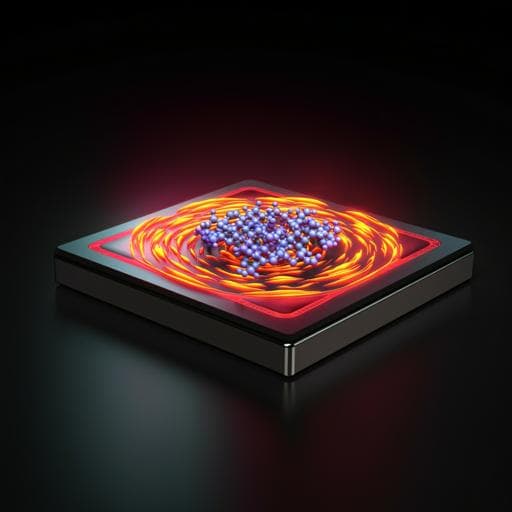
Engineering and Technology
A mid-infrared lab-on-a-chip for dynamic reaction monitoring
B. Hinkov, F. Pilat, et al.
Discover groundbreaking advancements in real-time molecular dynamics monitoring with a chip-scale sensor developed by Borislav Hinkov and colleagues. Utilizing innovative quantum cascade technology, this integrated device allows for precise in situ measurements of microliter samples, showcasing remarkable linearity and a wide concentration range while outshining traditional bulky systems.
~3 min • Beginner • English
Introduction
The study addresses the need for compact, sensitive, and selective mid-infrared (mid-IR) sensors capable of real-time, in situ monitoring of dynamic processes in liquids, such as chemical reactions and protein conformational changes. While mid-IR gas-phase sensing using quantum cascade (QC) technology is mature, liquid-phase techniques face challenges due to broad absorption bands in dense media and strong water absorption, typically necessitating bulky instrumentation and short effective optical paths. The authors propose a fully monolithic, fingertip-sized lab-on-a-chip sensor integrating a quantum cascade laser (QCL), a dielectric-loaded plasmonic waveguide, and a quantum cascade detector (QCD) on a single chip. The research aims to demonstrate two critical features beyond specificity and sensitivity: (i) label-free, real-time in situ measurement of dynamic processes with high temporal resolution, and (ii) on-chip analysis of microliter-scale liquid volumes with minimal interference in ongoing reactions. The device targets the mid-IR fingerprint region and specifically the protein amide I' band to achieve high specificity, and leverages plasmonic waveguides to overcome diffraction limits and extend interaction lengths beyond typical micrometer scales in liquids.
Literature Review
Prior work has established mid-IR spectroscopy as a powerful modality for chemical sensing, with QC technology enabling numerous gas-phase applications. In liquids, however, strong and broad absorptions and high water background complicate sensing, restricting path lengths to only a few micrometers and encouraging the use of bulky systems (FTIR, ATR-FTIR) for adequate sensitivity. Targeting the amide I (or amide I') band provides specificity for protein secondary structure analysis. Heavy water (D2O) is often used to shift water’s bending mode away from the amide I region, opening a spectral window that allows longer effective interaction lengths. Earlier studies largely provided qualitative analyses of protein denaturation and conformation in both H2O and D2O, with improved LODs achievable through more complex approaches such as SEIRAS combined with ATR elements or nanoparticle enhancements. Chip-scale photonic systems often encounter diffraction-limited mode confinement; plasmonic waveguides, particularly dielectric-loaded surface plasmon polariton (DLSPP) structures, can confine and guide modes with a high fraction of energy in the surrounding medium, making them attractive for liquid-phase sensing. Despite advances in source and detector performance (QCLs, QCDs), fully integrated on-chip sensors that deliver high temporal resolution, large dynamic range, and microliter-scale operation for liquid reaction monitoring have been lacking.
Methodology
Device design and fabrication: A monolithic QCLD sensor integrates a QCL emitter, a DLSPP plasmonic waveguide, and a QCD detector on an InP platform. The QCL employs a bound-to-continuum In0.53Ga0.47As/In0.52Al0.48As active region with 37 cascades grown by MBE, designed for same-frequency emission/detection around 6.5 µm targeting the amide I' region. A DFB grating in the upper cladding selects narrow emission within 20–40 cm−1 bands. The QCL (≈2.5 mm Fabry–Pérot ridge) and QCD (≈200 µm ridge) are connected by a 48 µm DLSPP waveguide comprising a 200 nm SiN slab atop a 60 nm Au layer, tapered from 10 µm at the QCL to 15 µm at the QCD. The sensor is directly submerged in liquid due to low analyte conductivity. Noise mitigation includes on-chip temperature monitoring and increased electrical contact separation; post-measurement electrical crosstalk correction is applied.
Optical simulations: FEM (COMSOL v5.5) eigenmode simulations characterized the DLSPP waveguide at 6.26 µm (1597 cm−1) and 6.17 µm (1620 cm−1). SiN refractive index was measured by mid-IR ellipsometry. Propagation lengths, effective indices, and losses were computed in air and assessed qualitatively in D2O and D2O+BSA via 2D top-view and longitudinal sections to evaluate confinement, coupling, and sensitivity to the surrounding medium.
Concentration series (submersion configuration): A 50 ml BSA in D2O stock (150 mg ml−1) was incrementally pumped (peristaltic pump) into a 30 ml D2O beaker while the QCLD sensor was submerged to continuously monitor concentration at 1597 cm−1 (QCD read by a 350 MHz oscilloscope). Temperature was tracked via a neighboring QCL biased at 0.5 mA (resistance-based probe) and a submerged Pt100. Baseline references in pure D2O preceded each BSA run. Absorbance vs concentration (A–c) calibration was constructed and compared to single-reflection ATR-FTIR references; effective path length (deff) was obtained by comparing slopes using Beer–Lambert law (deff,ATR = 0.838 µm at 1597 cm−1, ε from literature). LOD was evaluated from time-series noise (std over multiple 11 s intervals) and the low-concentration calibration slope (0–25 mg ml−1).
Thermal denaturation in a microfluidic cell: A custom 60 µl aluminum cell was mounted on the chip. BSA in D2O solutions at 20, 40, and 60 mg ml−1 were heated from room temperature to 90 °C, then cooled rapidly by passing through a 20 °C DI-H2O bath before entering the cell, ensuring measurement at 21 °C. Flow rate was 1 ml min−1. The QCL at 1620 cm−1 was pulsed (100 ns, 5 kHz) and the QCD signal was recorded (350 MHz oscilloscope). Crosstalk correction was applied using the expected absorbance ratio between 1620 and 1597 cm−1; a crosstalk of ~6 mV was determined. Sigmoidal Boltzmann fits were used to extract transition temperatures (x0), slopes (dx), and to compare normalized denaturation curves across concentrations.
Water submersion test: The sensor was operated while fully submerged in DI-H2O for ~1 minute to confirm operational robustness in highly absorbing matrices. Detector signal trends with small temperature changes (~0.1 °C) were recorded, indicating stability and enabling crosstalk estimation in fully absorbing conditions.
ATR-FTIR reference: FTIR spectra (Bruker Tensor 37, Platinum diamond ATR, single reflection) were acquired at 4 cm−1 resolution with 26 scans (≈60 s), using advanced ATR correction and OPUS 8.1 software. Quantitative measurements used 30 µl BSA in D2O (1–50 mg ml−1). LOD was calculated as 3·RMS noise / slope at 1597 cm−1. All spectra were recorded at 25 °C after dry-air purging.
Key Findings
- Fully integrated mid-IR QCLD lab-on-a-chip enabling real-time, in situ liquid-phase measurements with microliter sample volumes.
- Effective optical path length: deff,QCLD = 43.1 µm at 1597 cm−1, in good agreement with the physical 48 µm plasmonic section, and 55× higher absorbance than the single-reflection ATR-FTIR reference at the same wavenumber.
- Sensitivity and LOD: Time-domain noise analysis (std over 11 s intervals) gave LOD = 0.092 mV; with calibration slope (0–25 mg ml−1) ≈ −0.4 mV per (mg ml−1), the minimum detectable concentration change is 0.075 mg ml−1 (75 µg ml−1; 75 ppm by weight). This LOD is ~120× lower (better) than the ATR-FTIR setup used as reference.
- Dynamic range and linearity: Linear Beer–Lambert behavior across more than three orders of magnitude in BSA concentration, from 0.075 mg ml−1 up to >92 mg ml−1.
- Plasmonic waveguide performance (air): Propagation length Lp ≈ 1.692–1.814 mm; neff ≈ 1.002; losses ≈ 2.39–2.57 dB/mm (≈0.115–0.123 dB per 48 µm). Simulations show strong confinement persists in D2O with minimal change in lateral confinement and negligible index change from adding BSA.
- Real-time denaturation monitoring at 1620 cm−1: Sigmoidal absorbance vs temperature curves for 20, 40, and 60 mg ml−1 BSA with concentration-dependent transition temperatures (x0) that decrease with increasing concentration, consistent with literature. Reliable operation down to signal levels of ~10 mV after crosstalk correction (~6 mV).
- Robust operation in native-like conditions: The device operated submerged in DI-H2O, with full optical absorption by water leaving a residual electrical crosstalk signal useful for correction; no adverse effects were observed on pre- vs post-water measurements.
- Sample economy and speed: Microliter-scale flow cell (60 µl) and low flow rates (~17 µl s−1) support rapid, low-consumption dynamic measurements.
Discussion
The integrated QCLD platform directly addresses the challenge of monitoring fast, dynamic processes in liquids by providing high temporal resolution, strong analyte interaction via a DLSPP waveguide, and true in situ measurement in microliter volumes. By operating at protein-specific amide I' wavelengths, the sensor achieves chemical specificity while maintaining a long effective interaction length compared to conventional liquid-phase mid-IR methods. Quantitative calibration confirms Beer–Lambert behavior, enabling robust concentration readout across a broad dynamic range and yielding a substantially lower LOD than a state-of-the-art ATR-FTIR reference. Time-resolved monitoring of BSA thermal denaturation produced canonical sigmoidal transitions and concentration-dependent transition temperatures, demonstrating the platform’s capability for tracking conformational dynamics. Simulations corroborate the experimental performance and show that plasmonic confinement is preserved in D2O and only weakly perturbed by protein content, validating the device’s suitability for liquid-phase sensing. While the current optimization targets D2O to exploit a spectral window with reduced absorption, preliminary submersion tests in H2O confirm operational robustness and inform the design changes needed for operation in fully native matrices. Overall, the findings substantiate that monolithic mid-IR lab-on-a-chip technology can replace bulky offline analytics for dynamic reaction monitoring, and can be extended to multi-wavelength arrays for richer spectral information.
Conclusion
This work introduces a fingertip-sized, monolithic mid-IR lab-on-a-chip that integrates a QCL, a DLSPP waveguide, and a QCD for in situ, real-time analysis of liquid-phase reactions. The device delivers a long effective path length (≈43 µm), a low LOD (75 ppm by weight), and linear response across >3 orders of magnitude in concentration (0.075 to >92 mg ml−1), with 55× higher absorbance than an ATR-FTIR reference. It successfully tracks temperature-induced conformational changes in BSA at amide I' wavelengths and operates robustly even when submerged in water. Future work will focus on: (i) redesigning the plasmonic interaction length (≈10–15 µm) and optimizing wavelengths to avoid strong H2O absorption peaks for fully native measurements; (ii) implementing QC-based array concepts to access multiple wavelengths simultaneously; and (iii) exploring surface functionalization to further enhance sensitivity and selectivity for complex bioanalytical applications.
Limitations
- The primary measurements were performed in D2O to exploit a spectral window with reduced water absorption; while representative, this is not fully native biophysical conditions and transition temperatures differ slightly from H2O.
- The current device addresses a single wavelength per measurement; full spectral coverage would require arrays or tunability.
- Electrical crosstalk exists in the compact monolithic geometry and requires correction, particularly in highly absorbing matrices (e.g., H2O).
- Active temperature stabilization of the chip during submersion was not implemented; stability relied on bath conditions and monitoring only.
- For operation in H2O, the present 48 µm interaction length is too long; a redesigned geometry with much shorter path lengths is needed.
- Surfaces were not functionalized; while simplifying the approach, this may limit sensitivity/selectivity compared to SEIRAS or nanoparticle-enhanced methods.
Related Publications
Explore these studies to deepen your understanding of the subject.







